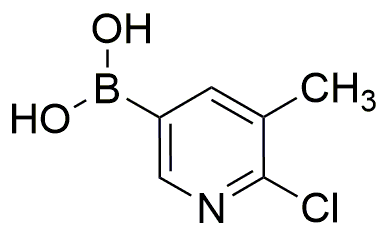2-Chloro-3-methylpyridine-5-boronic acid is widely utilized in research focused on:
- Synthetic Chemistry: It serves as a key building block in the synthesis of various organic compounds, particularly in the development of pharmaceuticals and agrochemicals.
- Catalysis: This compound is used in palladium-catalyzed cross-coupling reactions, which are essential for forming carbon-carbon bonds in complex organic molecules.
- Medicinal Chemistry: Researchers leverage its unique properties to design and optimize drug candidates, particularly in targeting specific biological pathways.
- Material Science: It is employed in the development of advanced materials, including polymers and nanomaterials, due to its ability to modify surface properties.
- Environmental Applications: The compound is explored for its potential in developing sensors for detecting pollutants, contributing to environmental monitoring efforts.
General Information
Properties
Safety and Regulations
Applications
2-Chloro-3-methylpyridine-5-boronic acid is widely utilized in research focused on:
- Synthetic Chemistry: It serves as a key building block in the synthesis of various organic compounds, particularly in the development of pharmaceuticals and agrochemicals.
- Catalysis: This compound is used in palladium-catalyzed cross-coupling reactions, which are essential for forming carbon-carbon bonds in complex organic molecules.
- Medicinal Chemistry: Researchers leverage its unique properties to design and optimize drug candidates, particularly in targeting specific biological pathways.
- Material Science: It is employed in the development of advanced materials, including polymers and nanomaterials, due to its ability to modify surface properties.
- Environmental Applications: The compound is explored for its potential in developing sensors for detecting pollutants, contributing to environmental monitoring efforts.
Documents
Safety Data Sheets (SDS)
The SDS provides comprehensive safety information on handling, storage, and disposal of the product.
Product Specification (PS)
The PS provides a comprehensive breakdown of the product’s properties, including chemical composition, physical state, purity, and storage requirements. It also details acceptable quality ranges and the product's intended applications.
Certificates of Analysis (COA)
Search for Certificates of Analysis (COA) by entering the products Lot Number. Lot and Batch Numbers can be found on a product’s label following the words ‘Lot’ or ‘Batch’.
*Catalog Number
*Lot Number
Certificates Of Origin (COO)
This COO confirms the country where the product was manufactured, and also details the materials and components used in it and whether it is derived from natural, synthetic, or other specific sources. This certificate may be required for customs, trade, and regulatory compliance.
*Catalog Number
*Lot Number
Safety Data Sheets (SDS)
The SDS provides comprehensive safety information on handling, storage, and disposal of the product.
DownloadProduct Specification (PS)
The PS provides a comprehensive breakdown of the product’s properties, including chemical composition, physical state, purity, and storage requirements. It also details acceptable quality ranges and the product's intended applications.
DownloadCertificates of Analysis (COA)
Search for Certificates of Analysis (COA) by entering the products Lot Number. Lot and Batch Numbers can be found on a product’s label following the words ‘Lot’ or ‘Batch’.
*Catalog Number
*Lot Number
Certificates Of Origin (COO)
This COO confirms the country where the product was manufactured, and also details the materials and components used in it and whether it is derived from natural, synthetic, or other specific sources. This certificate may be required for customs, trade, and regulatory compliance.


